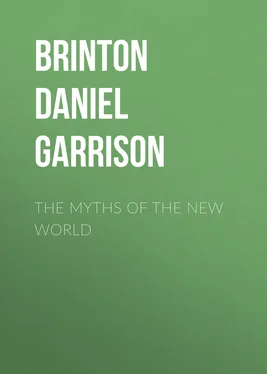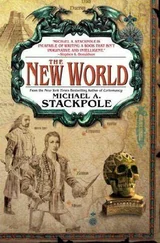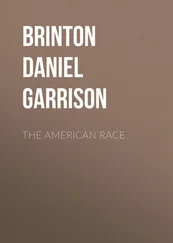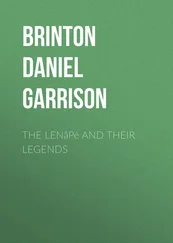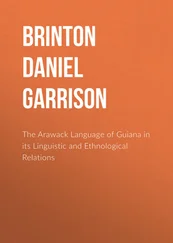Daniel Brinton - The Myths of the New World
Здесь есть возможность читать онлайн «Daniel Brinton - The Myths of the New World» — ознакомительный отрывок электронной книги совершенно бесплатно, а после прочтения отрывка купить полную версию. В некоторых случаях можно слушать аудио, скачать через торрент в формате fb2 и присутствует краткое содержание. Жанр: foreign_prose, История, Старинная литература, Мифы. Легенды. Эпос, foreign_edu, foreign_antique, на английском языке. Описание произведения, (предисловие) а так же отзывы посетителей доступны на портале библиотеки ЛибКат.
- Название:The Myths of the New World
- Автор:
- Жанр:
- Год:неизвестен
- ISBN:нет данных
- Рейтинг книги:5 / 5. Голосов: 1
-
Избранное:Добавить в избранное
- Отзывы:
-
Ваша оценка:
- 100
- 1
- 2
- 3
- 4
- 5
The Myths of the New World: краткое содержание, описание и аннотация
Предлагаем к чтению аннотацию, описание, краткое содержание или предисловие (зависит от того, что написал сам автор книги «The Myths of the New World»). Если вы не нашли необходимую информацию о книге — напишите в комментариях, мы постараемся отыскать её.
The Myths of the New World — читать онлайн ознакомительный отрывок
Ниже представлен текст книги, разбитый по страницам. Система сохранения места последней прочитанной страницы, позволяет с удобством читать онлайн бесплатно книгу «The Myths of the New World», без необходимости каждый раз заново искать на чём Вы остановились. Поставьте закладку, и сможете в любой момент перейти на страницу, на которой закончили чтение.
Интервал:
Закладка:
Finally, it has been justly observed by the younger Humboldt that the painful fidelity to the antique figures transmitted from barbarous to polished generations is injurious to the æsthetic sense, and dulls the mind to the beautiful in art and nature.
The transmission of thought by figures and symbols would, on the whole, therefore, foster those narrow and material tendencies which the genius of polysynthetic languages would seem calculated to produce. Its one redeeming trait of strengthening the memory will serve to explain the strange tenacity with which certain myths have been preserved through widely dispersed families, as we shall hereafter see.
Besides this of language there are two traits in the history of the red man without parallel in that of any other variety of our species which has achieved any notable progress in civilization.
The one is his isolation . Cut off time out of mind from the rest of the world, he never underwent those crossings of blood and culture which so modified and on the whole promoted the growth of the old world nationalities. In his own way he worked out his own destiny, and what he won was his with a more than ordinary right of ownership. For all those old dreams of the advent of the Ten Lost Tribes, of Buddhist priests, of Welsh princes, or of Phenician merchants on American soil, and there exerting a permanent influence, have been consigned to the dustbin by every unbiased student, and when we see such men as Mr. Schoolcraft and the Abbé E. C. Brasseur essaying to resuscitate them, we regretfully look upon it in the light of a literary anachronism.
The second trait is the entire absence of the herdsman’s life with its softening associations. Throughout the continent there is not a single authentic instance of a pastoral tribe, not one of an animal raised for its milk, 13 13 Gomara states that De Ayllon found tribes on the Atlantic shore not far from Cape Hatteras keeping flocks of deer ( ciervos ) and from their milk making cheese ( Hist. de las Indias , cap. 43). I attach no importance to this statement, and only mention it to connect it with some other curious notices of the tribe now extinct who occupied that locality. Both De Ayllon and Lawson mention their very light complexions, and the latter saw many with blonde hair, blue eyes, and a fair skin; they cultivated when first visited the potato (or the groundnut), tobacco, and cotton (Humboldt); they reckoned time by disks of wood divided into sixty segments (Lederer); and just in this latitude the most careful determination fixes the mysterious White-man’s-land, or Great Ireland of the Icelandic Sagas (see the American Hist. Mag. , ix. p. 364), where the Scandinavian sea rovers in the eleventh century found men of their own color, clothed in long woven garments, and not less civilized than themselves.
nor for the transportation of persons, and very few for their flesh. It was essentially a hunting race. The most civilized nations looked to the chase for their chief supply of meat, and the courts of Cuzco and Mexico enacted stringent game and forest laws, and at certain periods the whole population turned out for a general crusade against the denizens of the forest. In the most densely settled districts the conquerors found vast stretches of primitive woods.
If we consider the life of a hunter, pitting his skill and strength against the marvellous instincts and quick perceptions of the brute, training his senses to preternatural acuteness, but blunting his more tender feelings, his sole aim to shed blood and take life, dependent on luck for his food, exposed to deprivations, storms, and long wanderings, his chief diet flesh, we may more readily comprehend that conspicuous disregard of human suffering, those sanguinary rites, that vindictive spirit, that inappeasable restlessness, which we so often find in the chronicles of ancient America. The law with reason objects to accepting a butcher as a juror on a trial for life; here is a whole race of butchers.
The one mollifying element was agriculture. On the altar of Mixcoatl, god of hunting, the Aztec priest tore the heart from the human victim and smeared with the spouting blood the snake that coiled its lengths around the idol; flowers and fruits, yellow ears of maize and clusters of rich bananas decked the shrine of Centeotl, beneficent patroness of agriculture, and bloodless offerings alone were her appropriate dues. This shows how clear, even to the native mind, was the contrast between these two modes of subsistence. By substituting a sedentary for a wandering life, by supplying a fixed dependence for an uncertain contingency, and by admonishing man that in preservation, not in destruction, lies his most remunerative sphere of activity, we can hardly estimate too highly the wide distribution of the zea mays. This was their only cereal, and it was found in cultivation from the southern extremity of Chili to the fiftieth parallel of north latitude, beyond which limits the low temperature renders it an uncertain crop. In their legends it is represented as the gift of the Great Spirit (Chipeways), brought from the terrestrial Paradise by the sacred animals (Quiches), and symbolically the mother of the race (Nahuas), and the material from which was moulded the first of men (Quiches).
As the races, so the great families of man who speak dialects of the same tongue are, in a sense, individuals, bearing each its own physiognomy. When the whites first heard the uncouth gutturals of the Indians, they frequently proclaimed that hundreds of radically diverse languages, invented, it was piously suggested, by the Devil for the annoyance of missionaries, prevailed over the continent. Earnest students of such matters—Vater, Duponceau, Gallatin, and Buschmann—have, however, demonstrated that nine-tenths of the area of America, at its discovery, were occupied by tribes using dialects traceable to ten or a dozen primitive stems. The names of these, their geographical position in the sixteenth century, and, so far as it is safe to do so, their individual character, I shall briefly mention.
Fringing the shores of the Northern Ocean from Mount St. Elias on the west to the Gulf of St. Lawrence on the east, rarely seen a hundred miles from the coast, were the Eskimos. 14 14 The name Eskimo is from the Algonkin word Eskimantick , eaters of raw flesh. There is reason to believe that at one time they possessed the Atlantic coast considerably to the south. The Northmen, in the year 1000, found the natives of Vinland, probably near Rhode Island, of the same race as they were familiar with in Labrador. They call them Skralingar , chips, and describe them as numerous and short of stature (Eric Rothens Saga, in Mueller, Sagænbibliothek , p. 214). It is curious that the traditions of the Tuscaroras, who placed their arrival on the Virginian coast about 1300, spoke of the race they found there as eaters of raw flesh and ignorant of maize (Lederer, Account of North America , in Harris, Voyages).
They are the connecting link between the races of the Old and New Worlds, in physical appearance and mental traits more allied to the former, but in language betraying their near kinship to the latter. An amphibious race, born fishermen, in their buoyant skin kayaks they brave fearlessly the tempests, make long voyages, and merit the sobriquet bestowed upon them by Von Baer, “the Phenicians of the north.” Contrary to what one might suppose, they are, amid their snows, a contented, light-hearted people, knowing no longing for a sunnier clime, given to song, music, and merry tales. They are cunning handicraftsmen to a degree, but withal wholly ingulfed in a sensuous existence. The desperate struggle for life engrosses them, and their mythology is barren.
South of them, extending in a broad band across the continent from Hudson’s Bay to the Pacific, and almost to the Great Lakes below, is the Athapascan stock. Its affiliated tribes rove far north to the mouth of the Mackenzie River, and wandering still more widely in an opposite direction along both declivities of the Rocky Mountains, people portions of the coast of Oregon south of the mouth of the Columbia, and spreading over the plains of New Mexico under the names of Apaches, Navajos, and Lipans, almost reach the tropics at the delta of the Rio Grande del Norte, and on the shores of the Gulf of California. No wonder they deserted their fatherland and forgot it altogether, for it is a very terra damnata , whose wretched inhabitants are cut off alike from the harvest of the sea and the harvest of the soil. The profitable culture of maize does not extend beyond the fiftieth parallel of latitude, and less than seven degrees farther north the mean annual temperature everywhere east of the mountains sinks below the freezing point. 15 15 Richardson, Arctic Expedition , p. 374.
Agriculture is impossible, and the only chance for life lies in the uncertain fortunes of the chase and the penurious gifts of an arctic flora. The denizens of these wilds are abject, slovenly, hopelessly savage, “at the bottom of the scale of humanity in North America,” says Dr. Richardson, and their relatives who have wandered to the more genial climes of the south are as savage as they, as perversely hostile to a sedentary life, as gross and narrow in their moral notions. This wide-spread stock, scattered over forty-five degrees of latitude, covering thousands of square leagues, reaching from the Arctic Ocean to the confines of the empire of the Montezumas, presents in all its subdivisions the same mental physiognomy and linguistic peculiarities. 16 16 The late Professor W. W. Turner of Washington, and Professor Buschmann of Berlin, are the two scholars who have traced the boundaries of this widely dispersed family. The name is drawn from Lake Athapasca in British America.
Интервал:
Закладка:
Похожие книги на «The Myths of the New World»
Представляем Вашему вниманию похожие книги на «The Myths of the New World» списком для выбора. Мы отобрали схожую по названию и смыслу литературу в надежде предоставить читателям больше вариантов отыскать новые, интересные, ещё непрочитанные произведения.
Обсуждение, отзывы о книге «The Myths of the New World» и просто собственные мнения читателей. Оставьте ваши комментарии, напишите, что Вы думаете о произведении, его смысле или главных героях. Укажите что конкретно понравилось, а что нет, и почему Вы так считаете.
